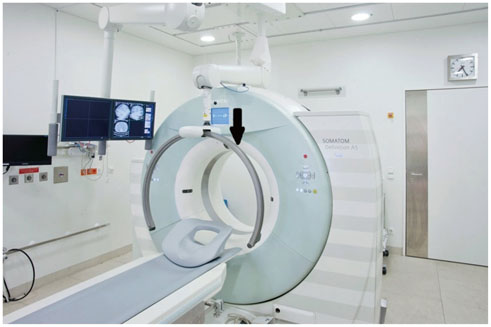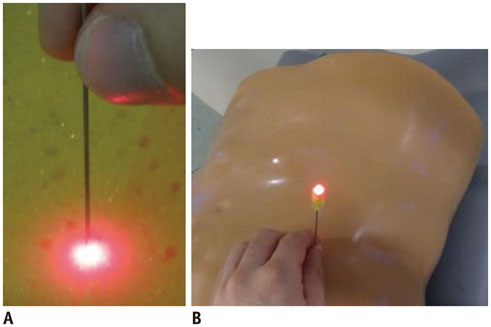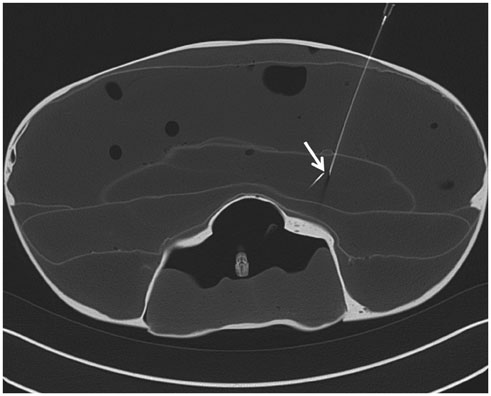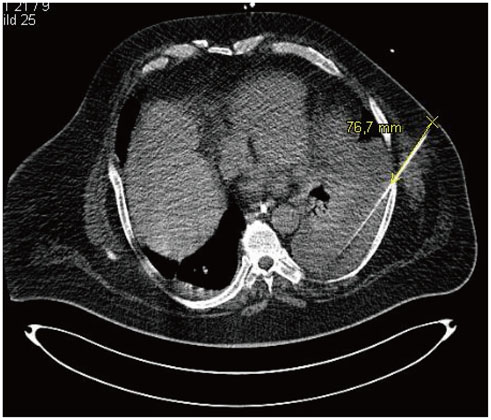Korean J Radiol.
2015 Aug;16(4):729-735. 10.3348/kjr.2015.16.4.729.
Intervention Planning Using a Laser Navigation System for CT-Guided Interventions: A Phantom and Patient Study
- Affiliations
-
- 1Institute for Diagnostic and Interventional Radiology, J. W. Goethe University of Frankfurt, Frankfurt 60590, Germany. tgruberrouh@googlemail.com
- 2Department of Radiology, Faculty of Medicine, Alexandria University, Alexandria 21514, Egypt.
- 3Department of Radiology, HELIOS Klinikum Erfurt, Erfurt 99089, Germany.
- KMID: 2155545
- DOI: http://doi.org/10.3348/kjr.2015.16.4.729
Abstract
OBJECTIVE
To investigate the accuracy, efficiency and radiation dose of a novel laser navigation system (LNS) compared to those of free-handed punctures on computed tomography (CT).
MATERIALS AND METHODS
Sixty punctures were performed using a phantom body to compare accuracy, timely effort, and radiation dose of the conventional free-handed procedure to those of the LNS-guided method. An additional 20 LNS-guided interventions were performed on another phantom to confirm accuracy. Ten patients subsequently underwent LNS-guided punctures.
RESULTS
The phantom 1-LNS group showed a target point accuracy of 4.0 +/- 2.7 mm (freehand, 6.3 +/- 3.6 mm; p = 0.008), entrance point accuracy of 0.8 +/- 0.6 mm (freehand, 6.1 +/- 4.7 mm), needle angulation accuracy of 1.3 +/- 0.9degrees (freehand, 3.4 +/- 3.1degrees; p < 0.001), intervention time of 7.03 +/- 5.18 minutes (freehand, 8.38 +/- 4.09 minutes; p = 0.006), and 4.2 +/- 3.6 CT images (freehand, 7.9 +/- 5.1; p < 0.001). These results show significant improvement in 60 punctures compared to freehand. The phantom 2-LNS group showed a target point accuracy of 3.6 +/- 2.5 mm, entrance point accuracy of 1.4 +/- 2.0 mm, needle angulation accuracy of 1.0 +/- 1.2degrees, intervention time of 1.44 +/- 0.22 minutes, and 3.4 +/- 1.7 CT images. The LNS group achieved target point accuracy of 5.0 +/- 1.2 mm, entrance point accuracy of 2.0 +/- 1.5 mm, needle angulation accuracy of 1.5 +/- 0.3degrees, intervention time of 12.08 +/- 3.07 minutes, and used 5.7 +/- 1.6 CT-images for the first experience with patients.
CONCLUSION
Laser navigation system improved accuracy, duration of intervention, and radiation dose of CT-guided interventions.
Keyword
MeSH Terms
Figure
Reference
-
1. Moser C, Becker J, Deli M, Busch M, Boehme M, Groenemeyer DH. A novel Laser Navigation System reduces radiation exposure and improves accuracy and workflow of CT-guided spinal interventions: a prospective, randomized, controlled, clinical trial in comparison to conventional freehand puncture. Eur J Radiol. 2013; 82:627–632.2. Nitta N, Takahashi M, Tanaka T, Takazakura R, Sakashita Y, Furukawa A, et al. Laser-guided computed tomography puncture system: simulation experiments using artificial phantom lesions and preliminary clinical experience. Radiat Med. 2007; 25:187–193.3. Yang CL, Yang BD, Lin ML, Wang YH, Wang JL. A patient-mount navigated intervention system for spinal diseases and its clinical trial on percutaneous pulsed radiofrequency stimulation of dorsal root ganglion. Spine (Phila Pa 1976). 2010; 35:E1126–EE113.4. Krombach GA, Schmitz-Rode T, Wein BB, Meyer J, Wildberger JE, Brabant K, et al. Potential of a new laser target system for percutaneous CT-guided nerve blocks: technical note. Neuroradiology. 2000; 42:838–841.5. Tovar-Arriaga S, Tita R, Pedraza-Ortega JC, Gorrostieta E, Kalender WA. Development of a robotic FD-CT-guided navigation system for needle placement-preliminary accuracy tests. Int J Med Robot. 2011; 7:225–236.6. Kloeppel R, Weisse T, Deckert F, Wilke W, Pecher S. CT-guided intervention using a patient laser marker system. Eur Radiol. 2000; 10:1010–1014.7. Palestrant AM. Comprehensive approach to CT-guided procedures with a hand-held guidance device. Radiology. 1990; 174:270–272.8. Bale R, Widmann G. Navigated CT-guided interventions. Minim Invasive Ther Allied Technol. 2007; 16:196–204.9. Ritter M, Rassweiler MC, Häcker A, Michel MS. Laser-guided percutaneous kidney access with the Uro Dyna-CT: first experience of three-dimensional puncture planning with an ex vivo model. World J Urol. 2013; 31:1147–1151.10. Zangos S, Müller C, Mayer F, Naguib NN, Nour-Eldin NE, Hansmann ML, et al. [Retrospective 5-year analysis of MR-guided biopsies in a low-field MR system]. Rofo. 2009; 181:658–663.11. Schell B, Eichler K, Mack MG, Müller C, Kerl JM, Czerny C, et al. [Robot-assisted biopsies in a high-field MRI system - first clinical results]. Rofo. 2012; 184:42–47.12. Moche M, Zajonz D, Kahn T, Busse H. MRI-guided procedures in various regions of the body using a robotic assistance system in a closed-bore scanner: preliminary clinical experience and limitations. J Magn Reson Imaging. 2010; 31:964–974.13. Zangos S, Melzer A, Eichler K, Sadighi C, Thalhammer A, Bodelle B, et al. MR-compatible assistance system for biopsy in a high-field-strength system: initial results in patients with suspicious prostate lesions. Radiology. 2011; 259:903–910.14. Becker HC, Meissner O, Waggershauser T. [C-arm CT-guided 3D navigation of percutaneous interventions]. Radiologe. 2009; 49:852–855.15. Proschek D, Kafchitsas K, Rauschmann MA, Kurth AA, Vogl TJ, Geiger F. Reduction of radiation dose during facet joint injection using the new image guidance system SabreSource: a prospective study in 60 patients. Eur Spine J. 2009; 18:546–553.16. Jacobi V, Thalhammer A, Kirchner J. Value of a laser guidance system for CT interventions: a phantom study. Eur Radiol. 1999; 9:137–140.17. Penzkofer T, Bruners P, Isfort P, Schoth F, Günther RW, Schmitz-Rode T, et al. Free-hand CT-based electromagnetically guided interventions: accuracy, efficiency and dose usage. Minim Invasive Ther Allied Technol. 2011; 20:226–233.18. Appelbaum L, Sosna J, Nissenbaum Y, Benshtein A, Goldberg SN. Electromagnetic navigation system for CT-guided biopsy of small lesions. AJR Am J Roentgenol. 2011; 196:1194–1200.19. Penzkofer T, Isfort P, Bruners P, Wiemann C, Kyriakou Y, Kalender WA, et al. Robot arm based flat panel CT-guided electromagnetic tracked spine interventions: phantom and animal model experiments. Eur Radiol. 2010; 20:2656–2662.20. Magnusson A, Radecka E, Lönnemark M, Raland H. Computed-tomography-guided punctures using a new guidance device. Acta Radiol. 2005; 46:505–509.
- Full Text Links
- Actions
-
Cited
- CITED
-
- Close
- Share
- Similar articles
-
- A Study on the Availability of the On-Board Imager (OBI) and Cone-Beam CT (CBCT) in the Verification of Patient Set-up
- Ultrasound-guided genitourinary interventions: principles and techniques
- Accuracy and Safety in Pedicle Screw Placement in the Thoracic and Lumbar Spines : Comparison Study between Conventional C-Arm Fluoroscopy and Navigation Coupled with O-Arm(R) Guided Methods
- Radiological Results and Assessment of Navigation-Guided Total Knee Arthroplasty
- Endoscopic ultrasound-guided vascular interventions: An overview of current and emerging techniques





